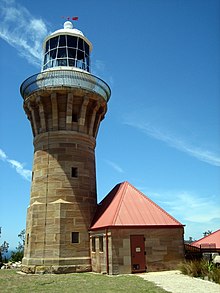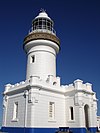Barrenjoey Head Lighthouse
 Barrenjoey Head Lighthouse | |
 | |
| Location | Broken Bay Sydney |
|---|---|
| Coordinates | 33°34′49″S 151°19′47″E / 33.580147°S 151.329796°E |
| Tower | |
| Constructed | 1881 |
| Construction | sandstone |
| Automated | 1932 |
| Height | 20 metres (66 ft) |
| Shape | cylindrical tower with balcony and lantern |
| Markings | unpainted tower and white lantern room |
| Power source | mains electricity |
| Operator | National Parks and Wildlife Service (New South Wales) |
| Heritage | Heritage Act — State Heritage Register |
| Light | |
| First lit | 1881 |
| Focal height | 113 metres (371 ft) |
| Lens | 2nd order Chance Brothers Fresnel lens[2] |
| Light source | electric power distribution |
| Intensity | 75,000 cd |
| Range | 19 nautical miles (35 km; 22 mi)[1] |
| Characteristic | Fl.(4) W. 20s Visible in sector |
The Barrenjoey Head lighthouse was the third light constructed on the Barrenjoey, New South Wales headland, and was completed in 1881.
History
Designed by NSW colonial architect James Barnet, its construction cost £13,695, plus £2,210 for the lamp. At an elevation of 113 m, it is visible to a distance of 19 nautical miles (35 km; 22 mi) out to sea.[1]
A customs station was established in 1843, as the Headland marked the entrance to Broken Bay and Pittwater – considered to be the back door to Sydney for smugglers. The first report of any lighted beacon on the headland was in 1855, when a fire was raised in a basket to assist mariners during storms. Broken Bay and the Pittwater were a safe haven in storms to vessels carrying coal from Newcastle to Sydney. Similarly, barges carrying food down the Hawkesbury River were a key food source for Sydney, and would harbour in the bay, awaiting favourable weather before making the 14 km journey to Sydney.[3]
Later, in 1868, two wooden lighthouses known as the Stewart Towers, were built at either end of the headland to guide ships in. The need for a permanent light led to the construction of the current lighthouse.
The current tower is unpainted, and built of the rich-coloured local sandstone. The original lighting apparatus was a fixed red dioptric of 700 candlepower with 4 oil wick burners. In 1900, an explosion followed by a fire destroyed the ornamental roof on the adjacent oil house. The flames were subdued before reaching the tower.
In 1932, the Barrenjoey Lighthouse was converted to automatic operation with the installation of an acetylene Dalén light of 6,000 candlepower. It was turned off and on by a Sun valve. Although the acetylene gas apparatus was efficient, access to the tower for re-supply presented problems, so in 1972 the lighthouse was converted to electric operation, with a new lamp capable of 75,000 candlepower.[4]
Keepers and cottages
There is a head keeper's cottage as well as 2 assistant keeper's cottages located on the headland. They are built from Hawkesbury sandstone quarried from the site, and have galvanized iron roofs.

Keepers of the lighthouse were:
- 1881 – 1885 George Mulhall
- 1881 – 1891 George Mulhall Jnr
- 1910 - 1920 Robert William Russell
- 1921 – 1925 Richard Sullivan
- 1925 - 1931 Robert William Russell
- 1931 – 1932 John Berryman
- 1932 – 1960 Cottages were unoccupied and subject to neglect and vandalism
- 1960 – 1997 The cottages were leased
- 1997 – Present The cottages were taken over by the National Parks and Wildlife Service, who removed many non-native plants and spent $230,000 restoring the cottages, lighthouse, and walking tracks.
For 31 years, from 1968 until 1999, Jervis Sparks leased Cottage 2 at Barrenjoey lighthouse, Palm Beach, NSW, Australia. It was an assistant keeper's cottage and had no electricity nor running water. When he took over the lease it was a vandalised ruin, and over many years he restored it to a comfortable 1800s era home, full of warmth and character. Sparks' Montreal born wife, Bridget, and he were married there in 1974. They were the unofficial caretakers of the lightstation and the headland.
In 1992 Sparks published the first definitive history of that lighthouse, Tales From Barranjoey, written on a Macintosh PowerBook 100 and powered via a solar panel. 3,000 copies were printed and the few remaining copies are collector's items[citation needed], as the book is now out of print.
Sparks was forced to vacate to Queensland when the management of all Australian lightstations (now all automatic and without any keepers or other protective human presence) was transferred from Commonwealth control, under the Australian Maritime Safety Authority (AMSA), to state control, which in this case was the National Parks & Wildlife Service (NPWS) of NSW. Sparks continues to advise NPWS on all historical and environmental concerns concerning Barrenjoey headland.
Before leaving, Bridget and Jervis Sparks were awarded the first-ever issued Pittwater Medal (modelled on the Australia Medal) by Pittwater Council for all their years of volunteer, historical and environmental work for the benefit of Barrenjoey, Palm Beach and the Northern Beaches in general. Jervis Sparks has decided to complete a quartet of books about Barrenjoey lighthouse, resulting in the second book, The Red Light of Palm Beach, detailing the lives of many of the lighthouse keepers who manned Barrenjoey from 1881 until 1932, when it became automated.
The light itself is currently operated by Roads and Maritime Services (formerly NSW Maritime).[5]
International Lighthouse and Lightship Weekend
Each year the Manly-Warringah Radio Society celebrate International Lighthouse and Lightship Weekend by activating an amateur radio station at the Barrenjoey lighthouse.[6] [7] The goal of the weekend is "to promote public awareness of lighthouses and lightships and their need for preservation and restoration, to promote amateur radio and to foster International goodwill". Over the course of the weekend some of the over 400 radio-active lighthouses around the world will be contacted from headland, usually on HF frequencies.
See also
Notes
- ^ a b According to List of Lights and "Lighthouses of Australia". National Parks and wildlife Landscape Plan, Accessed 2007-01-08, says 40km. Template:Wayback
- ^ Rowlett, Russ. "Lighthouses of Australia: Northern New South Wales". The Lighthouse Directory. University of North Carolina at Chapel Hill.
- ^ Macken, James J. Martin Burke: The Father of Pittwater. Anchor Publications. Holding: National Library of Australia. ISBN 0-9581340-3-0
- ^ "The Barranjoey Lighthouse at Palm Beach". Lighthouses of New South Wales. Lighthouses of Australia Inc. Retrieved 2007-01-07.
- ^ "Lighthouse Lights - NSW Maritime". maritime.nsw.gov.au. Retrieved 3 October 2010.
- ^ "Radio hams make Barrenjoey beacon". The Manly Daily. 11 August 2009.
{{cite news}}:|access-date=requires|url=(help) - ^ "Lighthouse Weekend". Retrieved 2013-05-15.
External links
- "Barrenjoey lighthouse". Dictionary of Sydney. Dictionary of Sydney Trust. 2008. Retrieved 7 October 2015. [CC-By-SA]
- "List of Lighthouses of New South Wales". Lighthouses of Australia. Lighthouses of Australia Inc.
- Searle, Garry. "List of Lighthouses - New South Wales". Lighthouses of Australia. SeaSide Lights.

